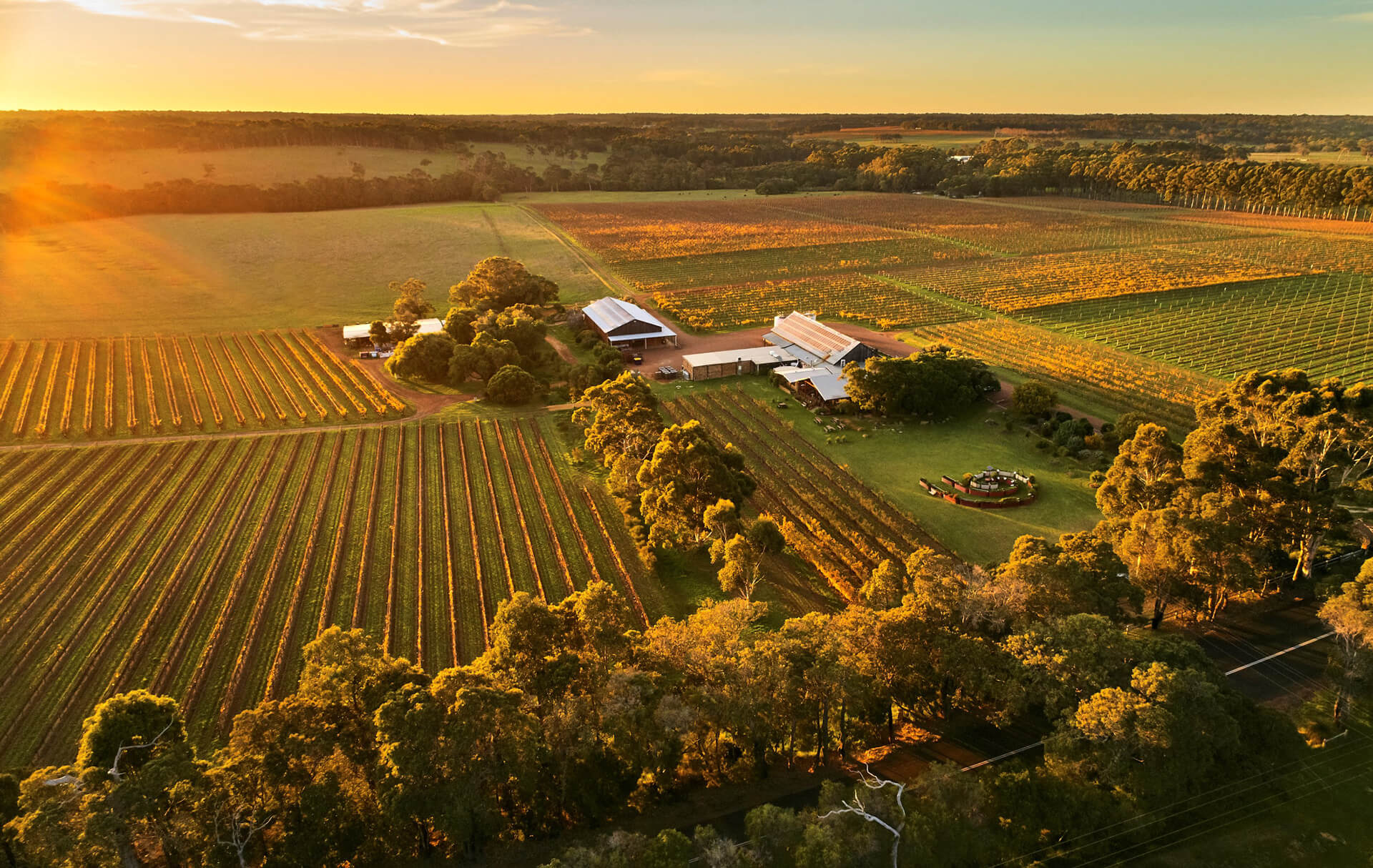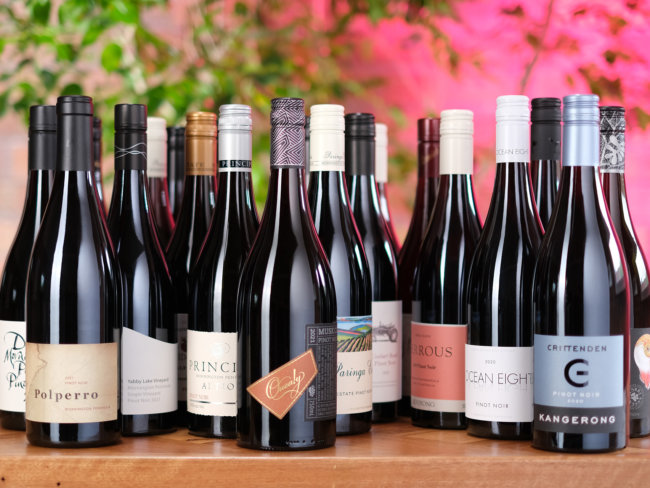If you’re after a wine region with a healthy dose of conspicuous glamour, then Margaret River has it all. Three hours south of Perth, ‘Margs’ is littered with iconic wineries, many with dazzling cellar doors and world-class restaurants. And then there’s the abundant sunshine, and the beaches – oh, those beaches… It’s a beautiful, beautiful place, and for a young wine region it’s very mature, with well-established paths to success built largely on the twin pillars of chardonnay and cabernet sauvignon (et al). Names like Cullen, Moss Wood, Woodlands, Leeuwin Estate and Vasse Felix feel like they’re etched in stone, but in the last little while, smaller players have been making their mark. Josephine Perry of Dormilona was our Young Gun for 2016, and this year’s Top 50 features small-batch makers tripe.Iscariot, LS Merchants and Arthur Wines.
Margaret River, A Modern Classic
Until Margaret River and the Great Southern were planted in earnest in the latter part of the 20th century, the Western Australian wine scene was dominated by this country’s second oldest wine region, the Swan Valley. Supremacy was snatched away from the venerable Swan rather abruptly, with Margaret River in particular establishing itself not just nationally, but internationally as well.
Chardonnay and cabernet-based wines from the region – as well as semillon and sauvignon blanc blends – became the emblematic wines, and those wines had distinct regional personalities, quite unlike comparable wines from anywhere else. The chardonnays were marked by both depth and poise, while the cabernets were powerful and stately. They were bold statements and they made quite the impression. And they still do.
“The pioneers of this remarkable area have instilled the region-wide obsession with quality, greater understanding of site, constant evolution, and aiming for the top on a global level. As part of the younger generation of wine growers in Margaret River, I try to never forget the work that has come before, and try and ensure that I am building on it, not breaking it down.”
Margaret River also became a significant tourist destination – now with over 200 labels and about 100 cellar doors – even though it is one of the country’s most ‘inconvenient’ wine regions. There are now direct flights to Busselton, but getting there previously meant a three-hour drive from Perth and a three-to-four-hour flight from other capital cities. It’s a commitment. The thing is, Margaret River is a special place, whether you’re into wine or not. It’s stunning country; the turquoise waters of the surrounding Indian Ocean are fringed by some of Australia’s best beaches, and there’s a laid-back charm to the place that so often accompanies established surf culture.
Enter the new wave
It was the surf that led Dylan Arvidson, of LS Merchants, to Margaret River. Well, not just the surf, but it sealed the deal over making wine in beach-less Orange, New South Wales. That job was at Juniper Estate, making classic Margaret River wines under Mark Messenger. With the encouragement of Messenger, Arvidson began to play with small batches of fruit, working both with lead varieties from different subregions and some ‘alternative’ varieties. His approach was one of minimal interference.
![]()
Dylan Arvidson at Injidup Beach, Margaret River.
“The first wines were distributed amongst friends and we grew to around five separate wines very quickly,” Arvidson says. “Moving forward, I became more comfortable in my winemaking and ceased altering the fruits initial composition – no tannin, acid, fining agents – and picked purely on flavour, not on numbers.”
Arvidson’s approach is a familiar one amongst the new guard of Margaret River, with a rethinking of the established, an exploration of the new, and a general desire for little meddling in the winery, showcasing variety and subregion.
Dormilona’s Josephine Perry (the 2016 YGOW) was the first of this new wave in Margaret River to establish a strong identity around making ‘experimental’ wines – skin-contact whites, extended skin-contact reds, fermenting and ageing in amphora – as well as viewing Margaret River’s classics through a new lens.
![]()
Josephine Perry of Dormilona hand labelling her wines. Photo by Sara Hewer.
This connection to what has come before is important, as is the connection to the makers of those established classics. Remi Guise, of tripe.Iscariot, credits his apprenticeship – at Domaine Naturaliste and their significant contract arm, Naturaliste Vintners – as being hugely influential. He is similarly charting his own course, but not necessarily as a challenge to the established order, rather with his wines as complementary foils.
“Bruce Dukes has taught me everything I know that is of any worth, both to do with wine, and to do with business. He is relentlessly passionate, driven and kind. I am lucky to still work with him,” Guise says. “My wines have evolved over time, from experimental and a touch raw, to what they are today, far more focused on balance and classicism, wines that are distinctive of the region and the sites they come from.”
Getting sub-regional
And it’s not just the new wave adding light and shade to regional expressions. Vanya Cullen, of Cullen Wines, runs arguably the most iconic winery of Margaret River, while also being one of its most progressive and creative makers. “We’ve got our ‘Supernatural Wines’, natural and ambers and all of that, which is unusual to have a brand that has the iconic classics, and then also those other ones which are a different expression of place, and as legitimate if they’re made in a quality way,” she says.
![Sunrise at Cullen Winery – birds eye view]()
Sunrise at Cullen in Wilyabrup. Photo by Frances Andrijich.
Although Margaret River is officially one region, it has six distinct subregions that were formally mapped in 1999, though not yet ratified. Many small makers are sourcing tiny parcels from across the region, uncovering and celebrating varietal expressions through the prism of subregion and site, as exemplified by tripe.Iscariot’s individual bottlings of Karridale and Wilyabrup chenin blancs.
Cullen believes formally declaring these districts is vital. Wilyabrup – where Cullen and many of the most iconic wineries are – has already gained interim approval from Wine Australia’s GI Committee, but moving past this interim status has been held up in red tape. “From the way we see it, or I see it, in terms of connection to the land, it’s a natural progression of the deepening of understanding of a place if you acknowledge the land like that, in that way,” says Cullen. “And it’s not just Wilyabrup, it’s like, wow, you’ve got Yallingup, and you’ve got all these other great places, too.”
Organic growth
This connection is critical for Cullen, with honouring and understanding the land’s nuances intrinsically tied to leaving it better than you found it. The Cullen vineyard has been organic since the late 90s and certified biodynamic in both the vineyard and winery since 2003, and although this approach has been slow to catch on across the region, much is changing. Makers like Perry and Liv Maiorana and Mijan Patterson of South by South West (2019 YGOW People’s Choice) now work largely with organic and biodynamic growers, while Arvidson leases two vineyards that are in conversion to organics. And these vineyard practices are becoming increasingly common, even among the bigger players.
“Well, it is encouraging,” says Cullen. “There is a groundswell of more organic producers, which is fantastic. You’ve got the Organic Wine Trail, which is for producers certified in both the vineyard and winery, 100 per cent, and that’s got five or six people on it. And you’ve got the bigger producers that are converting some vineyards to organic, like Voyager and Vasse Felix. So that’s a long process for them to commit to.”
![]()
With their commitment to biodynamic viticulture, Cullen go to the enth degree. Here, their vineyard manager is making compost. Photo by Frances Andrijich.
Today, Margaret River is as much about the tried and the true as it is about colouring outside the lines, from the boundary pushing wines of Perry, Guise, Arvidson et al to the re-imagining of fortified wines by Tash Arthur of Arthur Wines – a bold and exciting gambit in a wine world dominated by table wines. Whatever the approach, the wines of Margaret River are underscored by a deep love for the region and an appreciation for its short but rich history.
“The unspoken facet of terroir has always been the human influence, and just like your childhood holds many indicators as to who and how you will be later in life, so your founders do for a wine region,” says Guise.
“The pioneers of this remarkable area have instilled the region-wide obsession with quality, greater understanding of site, constant evolution, and aiming for the top on a global level. As part of the younger generation of wine growers in Margaret River, I try to never forget the work that has come before, and try and ensure that I am building on it, not breaking it down.”
The Wines
Arthur Wines ‘Glass Slipper’ $22
(Fortified chardonnay with a little semillon.) This has a super bright grapey feel, with notes of lime pith, lemon leaves, white peach, cut herbs and golden raisins. There’s richness and sweetness here, but the fortification of alcohol (17.5%) and vibrant acidity pull that sweetness in, finishing bright and fresh. This takes a chill, and it works extremely well with ice and a big wedge of lemon squeezed in – a splash of soda wouldn’t hurt either.
Arthur Wines Barrel Aged Muscat $35
Lifted notes of brandy-soaked raisins, dried figs and medjool dates, with buffering warm brown spices, notably cinnamon. This is deeply flavoured and nuanced, quite exotic, intense and luscious, with the balance of sweetness and alcohol warmth beautifully judged.
2019 LS Merchants Wilyabrup Chardonnay $35
This is in a pretty classic mould, with super-zesty citrus notes, peach, nectarine, a flash of classy oak with barrel ferment and lees plushness; a matchstick character, lime peel and grapefruit pith. This is ultra-bright, with plenty of chardonnay hooks, texture and presence, but it has super race and drive to it too. The acid blazes through the palate collecting all the citrus and stone fruit flavours with notes of nougat, too.
2019 LS Merchants ‘Whole Bunch’ Mataro $35
This is very aromatic, juicy and vibrant, small black plums, wild red berries, boysenberry, blueberries, spices, black tea leaf, red and blue floral notes. This is an interesting play on what can be a dark and often gruff variety. There’s plenty of fruit intensity and weight here, but it’s buoyed by the making, with some spritz, pithy and chalky tannins and a slight saline note. It’s pretty, a little wild, and both gulpable and intense.
2019 tripe.Iscariot ‘Aspic’ Grenache Rosé $32
Faint blush of rosy coppery pink. This is bright and red fruited, but super fine and elegant, with notes of sour red berries, pomegranate, watermelon, redcurrant, red florals, cranberry, freeze-dried raspberry and a lightly spicy herbal note. The palate is dry and linear, with enough texture to pull it back from austerity, a study in subtle detail.
2018 Tripe Iscariot ‘Stygian Bloom’ Cabernet Sauvignon $52
Dark and plush, quite commanding and brooding, with mulberry, dark berries, tea leaf, cedar, dusty spice, wet tobacco and a darkly tarry mineral note. The tannins are fine, and the fruit rich and silky in feel with real presence and weight carried by that web of super-fine tannins. Cedar and roasted coffee bean notes from the oak mingle with dark berries and dusty spices through the long finish.
See the full list of Top 50 winemakers in the 2020 Young Gun of Wine Awards here. Join in our virtual events here, and also vote on who wins the People’s Choice until June 1.










